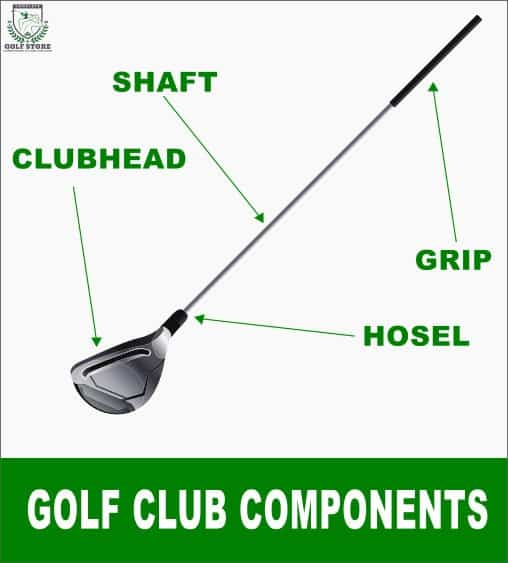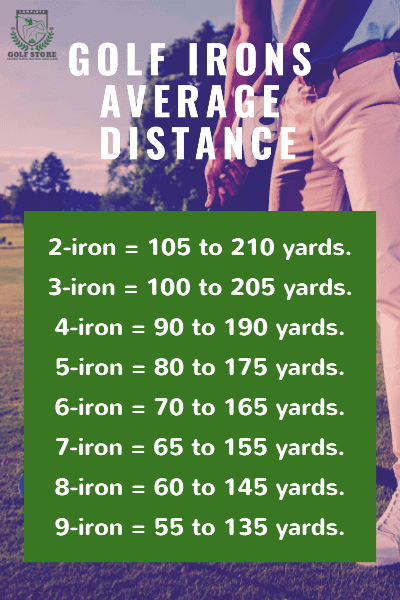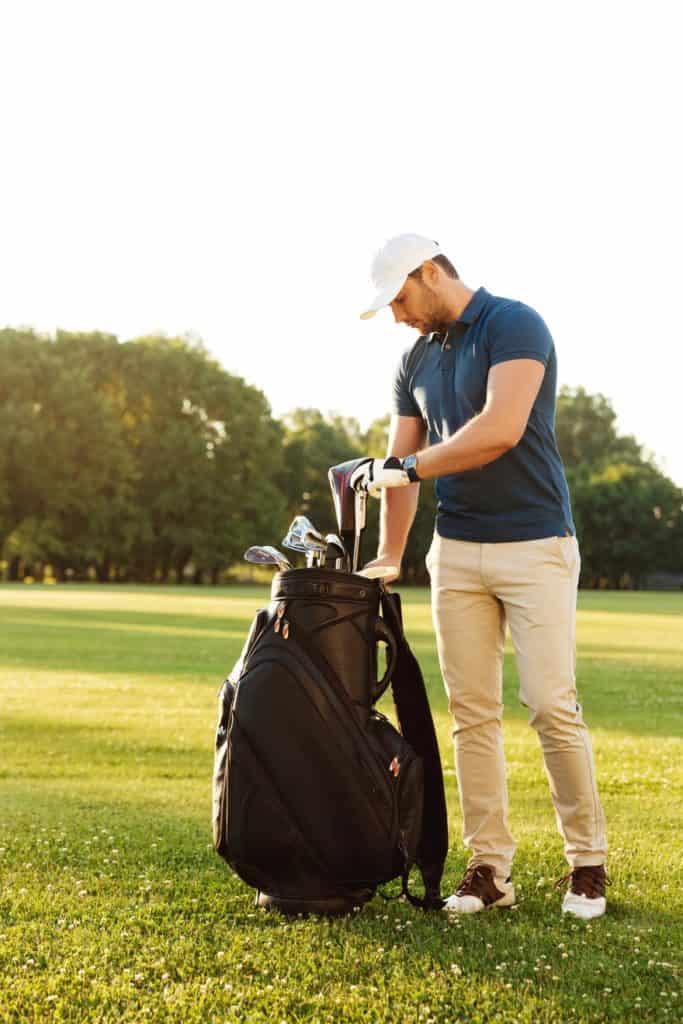Picking the proper golf equipment (especially clubs) is essential to enhance your performance. Using the right golf club for the appropriate condition can hugely impact your play.
If you’re new to this sport, it might be challenging to know which type of golf club you should use and for which situation.
However, if you have some experience, you should not face many difficulties when making such decisions.
Everything related to golf clubs for different levels and uses can be found in this article, discussed in detail. In the end, we will answer some of the most frequently asked questions to help you make the right choices when buying your golf clubs.
Let’s get started!
- 1) What Are the Different Types of Golf Clubs?
- 2) Golf Club Components
- 3) How to Know Which Golf Club to Use and When?
- 4) Should I Use a Fairway Wood or Hybrid?
- 5) Now That You Are More Familiar With the Types of Golf Clubs, What About the Golf Club Numbers?
- 6) What Is Offset, and Why Are Some Golf Clubs Designed With It?
- 7) Golf Selection Chart for Men and Women
- 8) How Many Clubs Can a Pro Golfer Carry?
- 9) Frequently Asked Questions
- 10) Conclusion
What Are the Different Types of Golf Clubs?

The different types of clubs are mainly designed to hit the ball at various distances. So, you will find numerous degrees of loft to propel the ball forward into the air.
The standard golf set consists of multiple clubs so that the player has a club for each shot he/she wishes to make.
You will also find that these clubs have numbers on them. The clubs with lower numbers are used to hit the ball for longer distances when compared to the higher-numbered ones.
Here is a video (10 minutes 18 seconds) from Clay Ballard explaining the difference and role of every type of golf club:
Golf clubs also have different shapes, weights, and sizes to cater to numerous situations and shots. Let’s have a look at each of these:
Putters
Putters are the most useful and critical gear in your bag. You get to use the putter while on the green to roll your ball into the hole.
They come with a steel shaft and, at times, have a squared or flat putter grip to rest your thumbs. They are sometimes called the ‘flatsticks’ as they have the lowest loft among golf clubs.
You will find that the clubface on the putter is actually flat or almost flat, which makes it smaller than the rest of the clubs in your set.
Two types of head styles are available for the putter: the blade and the mallet -the blade putter sports a small head style, which is the traditional style.
Blades are still used today but have been replaced with mallet types that allow more control over distance and direction. Mallets were first introduced in the 1930s.
The mallet putter has a larger head style and is suitable for all skill levels. This is a popular option as it’s capable of giving straight putts and provides a wider, more forgiving margin of error.
A hybrid between a blade and a mallet is called a “hybrid” putter. These combine the advantages of both styles. Some hybrids include a head like a blade and a shaft like a mallet. Others have a head shaped like a mallet and a shaft similar to a blade.
Putters can also be categorized in terms of balance. A face-balanced putter has a face that faces skywards when balanced on a finger, with a center of gravity below the shaft axis, making them better suited for golfers with a straightforward putting stroke.
On the other hand, a toe-balanced putter (Toehang) points to the ground when balanced on a finger. They are usually suited for players with an arc in their putting stroke.
There are also kinds of putters designed specifically for women; they usually sport considerably thinner grips to fit women’s smaller hands and offer better control and pressure consistency.
Finally, some players choose to use putters with extra-long shafts of up to 50 inches, mainly for better stability and balance (thanks to their deep center of gravity). These are usually referred to as “Broomstick putters“.
Fairway Woods
Fairway woods, also known as Metal Woods or Fairway Metals, are clubs with the same general shape as a driver but slightly smaller in size, with a shaft that is slightly shorter and stiffer.
The clubhead has a larger sweet spot and more loft than a standard iron, but smaller than a driver. As a result, a golfer can use it to hit longer drives or approach shots closer to the green. It also provides better control over distance because of its higher launch angle.
The loft can range between 15 and 18 degrees for the 3-wood and 20 to 22 degrees for the 5-wood, whereas the driver lies between 7 to 13°. The higher the number, the greater the loft of your clubhead, which will impact your shot as well.
5 and 3- woods are called fairway woods since they are usually used while in the fairway of the hole; 7, 9 and 11-woods are commonly referred to as “utility woods” for their versatility.
For high handicappers, it’s advisable to have 17° (or anywhere between 15 and 18). Golfers who find it hard to hit using a driver may opt for fairway woods instead. The extra loft helps in hitting straight shots.
Check also our detailed guide on 3-woods vs. drivers and when to choose each of them.
Fairways are generally used for driving ranges, around putting greens, in practice areas, etc., where there is enough room to allow players to take full swings without hitting anything.
Wedges
Iron Wedges help strike the ball and make it fly into the air before it lands on the putting surface. As a result, they have a much higher loft when compared with the rest of the clubs.
These clubs have a loft of around 50°. Based on the different loft degrees, you will find three types of wedges. They include the gap, sand, and lob wedges.
Based on the bounce angle, you will also find that three types of wedges are available, including the standard, low, and high bounce wedges. The bounce angle is the curved portion present on the soles of the wedge. This keeps the club from snagging into the rough or sandy areas.
The Gap Wedge
Also known as the approach wedge. This club can bridge the gap of the distance between the sand wedge and the pitching wedge.
Also, this club permits more distance than the rest of the wedges. It also gives better accuracy for each shot and offers a loft that lies between 50 to 54°. This wedge is mainly used for hitting a ball with a shorter, higher trajectory.
The Sand Wedge
The sand wedge, also known as sand iron, is the most commonly used wedge for making sand bunker shots. You can also make many shots across the green to get the ball into the air and spin it after it hits the green.
If you’re a high handicapper looking for wedges designed to improve your game, consider exploring wedges designed for high handicap golfers, which can provide valuable assistance with your short game.
This open-faced wedge has a wide sole that offers an enormous amount of bounce. This allows the clubhead to glide nicely through the sand without getting hindered by it. Even though it does not provide a long-distance hit, it is a valuable tool in your bag. You can use it for bunker plays since it has 54 to 58 degrees of loft.
The Lob Wedge
Also known as the L-Wedge or lofted wedge. It is usually used to make short-distance shots capable of spinning a lot and traveling relatively high.
This club allows the player to manipulate the ball across the greens using shots that can stop rapidly, or else make higher shots that are capable of spinning back into the hole. These wedges range between 60 to 64 degrees loft angles.
Hybrid Golf Clubs
The hybrid golf club is a crossbreed between an iron and a wood club. The best Hybrid clubs have the same shape as that of woods and have a more significant advantage of being able to hit easily.
You will find that they also have the length and loft of an iron club, making it easier to achieve the same distance as that of an iron.
Most individuals have the affinity to replace their long irons like the 4-irons and 3-irons with the hybrid option. This is mainly done to enhance the forgiveness and ease of playability in off-center hits.
Although 4-irons and 3-irons are usually replaced, you can also replace the other irons with hybrid clubs to hit easily. For example, the 5-hybrid can be used to replace your 5- and 6-irons; the 4-hybrid can replace the 4-iron, etc.
However, you should be careful when replacing your clubs because if you do not know what type of golf swing you use, you may end up hitting them the wrong way. If this happens, you might damage or even break these clubs.
If you want to learn how to improve your game by using the right hybrids, then you need to get some advice from professionals who specialize in teaching people about different types of golf equipment. They will help you choose which ones suit your needs and preferences. By doing so, you will learn how and when to use your hybrids without the risk of damaging your valuable investment.
Irons
Golf irons are capable of covering long, midrange and short-range shots and can be used in a variety of situations. These include long irons (2, 3 & 4-irons), mid-irons (5, 6 and 7) and short irons (8, 9-irons & the pitching wedge).
Most of the time, they are used in the fairway when the player is closer to the green, but can sometimes be used off the tee; they can even be used to extract the ball from hazards. Generally, they’re available in sets of 6 to 8 individual clubs. The typical set contains 9-, 8-, 7-, 6-, 5-, 4- and 3-irons.
Iron clubs are available with graphite or steel shafts. The irons’ smaller and thinner heads give them a more traditional look (that of a blade) but offer more forgiveness than their predecessors. Sometimes, they also feature an offset hosel for improved accuracy of off-center hits. Based on your weight requirements, different models are available, including Offset, draw-weighted Irons, and Perimeter-weighted Irons.
Check Also: Best Golf Irons of All Time
Offset irons, also called offset hosel clubs, have their leading-edge sitting back from the club shaft. The draw-weighted iron places more weight on the club hosel, making the heel much heavier than the toe of the club.
Perimeter-weighted irons use perimeter-weighting, a feature that is used in modern clubs to make golfing much easier for the less-skilled players; this is achieved by placing more weight towards the edges (perimeters) of the clubhead and less on its center, providing a wider sweet spot and making the club more forgiving. Perimeter-weighting results in a “cavity-back design’ (because of the cavity on the back of the club).
You will also come across other types of irons while picking golf club iron sets, with each uniquely designed to suit a specific skill level. These include Muscle Back (traditional iron with thin and solid back – providing more flexibility) or Cavity Muscle Back (Thick and hollow), Game Improvement Irons, and Max Game-Improvement Irons (Usually easier to hit than other models- most useful for beginners or skilled players with a moderate handicap).
Drivers
Drivers are traditionally known as the 1-woods. In the past, they were made using wooden material. However, in the modern era, you can find titanium, steel, and other material drivers. For example, TaylorMade uses carbon wood for its stealth 2 driver series.
Drivers come with the largest club head in the golf bag and are the long-distance clubs. They are mostly used for the initial shots on Par 4s or Par 5s. The largest legal head size, as per USGA regulations, is 460cc.
The driver’s face has the largest hitting area (and sweet spot) when compared to the other types of clubs. You can also find different clubhead sizes while selecting the drivers.
While purchasing your driver, you should always avoid going for cheap ones. It’s also advisable to choose drivers that suit your swing style. Otherwise, you may experience a variety of issues like loss of carrying and total distance, excessive spin, etc.
Heavier driver heads are more suited for players with faster swings, as they will help them achieve longer distances and enhanced ball speed. Lighter driver heads are better used by slow to moderate swingers, as they help them get the ball airborne off the tee more easily and swing faster.
There are many flex ratings for driver shafts (as with most club types); these include stiff (S), extra stiff (XS), regular (R), and Seniors (A). Some more extra stiff drivers can go as high as the XXS and XXXS drivers (The stiffest shafts with the lowest flex degrees). Moreover, there are types of drivers specific for women called light flex or ladies flex (L).
Choosing the right flex rating for your club is optimal for achieving the best shots; stiffer shafts are more suited for fast swingers and experienced golfers, while more flexible ones can help slow swingers and average golfers achieve more distance.
It is also worth noting that modern drivers benefit from game-improvement designs and features such as movable weight systems, perimeter weighting, low center of gravity & high moment of inertia, adjustable hosel and loft systems, etc.
Are you looking for your next golf driver? Check out our list of the best golf drivers in the market today.
Golf Club Components

Now that you know what a complete club set includes, let’s find out the essential golf club components.
Each club consists of four parts: the Shaft, clubhead, grip, and Hosel. A component golf club is a golf club that’s assembled by any independent club manufacturer. These club makers usually get the parts of the club from specialized vendors.
The Shaft
The shaft is a cylindrical and tapered tube made of metal or graphite. It connects the hand of the player with the clubhead. As for the length of the shaft it varies based on the club it’s installed in.
The longer the length of the shaft, the farther your hands will be from the ball ( compared to shorter shafts). You will find that most of the long clubs are made using graphite shafts because they are flexible in nature.
While selecting the shaft, you need to be aware of your swing speed as well. You can find this out through the fitting procedure while you purchase the club. Golfers with a swing speed of more than 100 mph must opt for an extra stiff or stiff shaft.
For swing speeds between 85-100 mph, a regular flex shaft is ideal. However, swing speeds lower than 85 mph must go for more flexible shafts (senior or ladies).
The Shaft Stiffness levels are usually labeled using various letters:
- – L for ladies.
- – M or A for seniors or amateurs.
- – R for regulars.
- – X for extra stiff.
- – S for stiff.
The Clubhead
Golf club heads are the part of the golf clubs that you can hit the ball with. You need to have different-sized club heads in your bag to achieve the best possible speeds, distances and results.
Moreover, the head controls the distance and the height that your ball may travel. Club heads are specially designed with unique technological attributes by the manufacturer. This gears it to suit each player’s ability to strike the ball accurately and make it propel forward.
Most of the specialized club brands provide oversized, midsize, and standard heads for their clubs. Note that choosing the clubhead size is mainly based on your expertise level. The larger the size of your clubhead, the more forgiveness you will have for your swings.
The Grip
First off, we need to make a distinction between the golf grip and the “club grip”. The first refers to the way the player grips the club in his/her hands, while the latter is the physical part of the club, which we are interested in here.
The grip includes a rubber covering that goes over the last 8 inches of your shaft. This enables you to hold or grip the club tightly. You may come across clubs that have jumbo or oversized, midsize, and standard golf grips.
The grip thickness can have a massive impact on your swings. Golf club grips that are too thin may result in larger hand actions as you swing. Whereas grips that are too thick may restrict your hand movements, causing devastating results.
The right grip will allow you to hold the club with the help of your middle and ring fingers on your left hand with minimal contact with your thumb on the pad.
Grips are chosen depending on the size of the golfer’s hands. You can also select based on the various textures, shades, and designs; however, remember that all these serve the same purpose.
The Hosel
The Hosel is the part that connects the clubhead with the shaft and is capable of controlling the lie angle of the club. The lie angle is the angle between the shaft and the sole of the clubhead. At times, golfers may have to adjust their lie angle depending on their swing style, arm length, and height.
If you have to bend your shaft to increase the angle, it shows you have an upright lie angle. On the other hand, if you have to decrease the angle, then what you get is a flat lie angle.
An adjustable hosel does the same job at the hosel. However, here the golfers can adjust the lie angle and loft of the club. These adjustable hosels are available only recently and are present in only fairway woods, hybrids, and drivers.
How to Know Which Golf Club to Use and When?
Well, you have all the tools you need for a successful shot but understanding which golf club to use in which situation can be a challenge. Most golf clubs are designed for particular shots, although some have multiple uses.
Do you go with a wood or a hybrid? Which iron will help you perform your best shot? Which wedge will help you land on the green?
To decide which golf club to use for a specific shot, you need to identify each golf club’s average distance in your set. Then, you choose the golf club that meets the length you want to achieve.
Watch this short video about the uses of each club and what they do (5 minutes 46 seconds):
Driver
The driver will usually be the primary club you start with during the round for tee shots. Drivers are specially meant to give you the maximum distance from the tee. Therefore, they usually are the longest clubs in your bag and will have the lowest loft of the clubface, which affects your shot’s distance and trajectory.
As mentioned before, the choice of your driver is crucial to the results you get. If you make the wrong choice, you may ruin the whole game due to the many problems that may occur. The most crucial things to consider while choosing the driver are your swing speed, age, and gender category; then, you will be selecting the proper driver for you among different clubhead sizes and shaft stiffness and flexibility ratings.
Since knowing your swing speed is crucial here, one good way of calculating it is to swing 50 times with the club; in the end, you remove the five fastest and five slowest swings. Then, the calculation of the remaining swings gives the right average swing speed.
Hybrids
Hybrids are a mixture of fairway woods and irons producing the best aspects of both. Hybrids are utilized to replace some of the more difficult medium and long-distance irons and replicate those distances. Hybrids may also be used to help increase your shot control without taking away distance or trajectory.
Hybrids are great clubs to use by golfers of different levels, especially for beginners, as they are more forgiving and offer a wider margin of error. So, even if your swing is not very good, distance and trajectory are not affected too much and the performance and result will still be acceptable. Just imagine how frustrating golf would have been for many players if hybrids had never been invented.
Once again, the player must pay attention to which hybrid clubs can be used to replace which irons to avoid damaging or even breaking the clubs. We have mentioned before that usually 3-iron and 4-iron are the clubs replaced by hybrids. Still, with proper knowledge, guidance, and help from professionals, any golfer can replace most of the irons with hybrids for a better overall game and easier, more forgiving swings.
Irons

The iron golf clubs are explicitly used for hitting balls from the fairway to the green. Shots from large and medium irons (or middle iron) move farther, while short-iron shots fly higher but for a shorter distance, and their stop can be controlled easily. Your iron set may start with the 5-iron (a loft of about 30 degrees). The pitching wedge is the shortest iron, and it has a loft of about 46 degrees.
In addition to the category of long irons (that includes irons 2,3 and 4) and the short irons (including irons 8 and 9 in addition to the pitching wedge), there is another category of mid-irons in which we can find the 5, 6 and 7 irons. The rule is that the higher the number, the shorter the distance, the higher the loft, and vice versa. Choosing the right iron depends on the specific needs of each shot.
Fairway Woods
Despite their name, which refers to wood, these clubs are made of stainless steel. The shaft is set off-center in the large head, and the grounded bottom lets the head slide over the grass. Most golfers use them beyond the range of irons when they want more control of the ball. For example, you can use a fairway wood from the fairway or a good lie in the rough or off the tee if you struggle with the driver.
For golfers who have difficulties using drivers, especially beginners, Fairway woods can be used instead because they provide higher lofts. In addition, as mentioned earlier, fairway woods can be used in any area where the golfer can take full swings without the possibility of hitting anything. As with other golf clubs, fairway woods use numbers to indicate the degree of loft they provide. The higher the number, the higher the loft angle.
Wedges
The iron Wedges help produce shots of varying distances and get you out of difficult situations. You can use gap, sand, and lob wedges for short pitches from the fairway and getting out of sand traps, for example.
Golfers usually carry various wedges with different lofts and bounce angles for multiple distances and lie conditions. Choosing the right wedge depends on the sticky situation you are in. Pitching wedges and sand wedges are usually included in standard golf sets.
They have a loft of between 44 and 58 and can be used to hit the ball for a distance between 110 and 140 yards (for the pitching wedge) and 80 to 110 yards (for the sand wedge). The pitching wedge is usually used when you try to go for the green, while the sand wedge can get you out of the golfers’ worst nightmares: sand traps and bunkers.
Gap wedges and lob wedges are normally not included in standard club sets, so they need to be purchased separately. A gap wedge somehow fills the gap between pitching and sand wedges, as it can be used in situations where both are not the best choice (when you need to cover a distance that is too long for the sand wedge, but at the same time, too short to use a pitching wedge). A gap wedge has a loft between 46 and 54 degrees and flies about 90 to 110 yards.
Lob wedges have the highest loft among all golf clubs, ranging between 60 and 65 degrees. They also cover the shortest distance among wedges, usually under 80 yards. Thus, lob wedges are handy for precise shots to the green.
Putters
Once you are on the green, it’s time to use your putter on the surface surrounding the hole. As the purpose is to make relatively short and low-speed strokes, putters have flat faces with only about 4 degrees of loft to keep the ball from bouncing up when you strike it. In addition, many putters have plastic or soft metal face inserts to roll the ball more smoothly.
Putters are categorized into the more traditional blades, and the easier, more forgiving modern mallets. There are also hybrid putters, combining the best of both worlds (blades and mallets), and ones that are specifically designed for women. The goal is to achieve much more precision with less or almost no speed, bounce, or loft (usually, it’s around 2 to 4 degrees). However, the length of the putter is the most crucial criterion in selecting your putter since it determines how well you will hit the ball.
Should I Use a Fairway Wood or Hybrid?
Fairway woods are sometimes used instead of drivers if, for some reason, the driver goes missing. This is because they are smaller than drivers but provide better control to hit straight. For some players, however, fairway woods are not very easy to use, especially those with slower or steep swings or those having problems with shots on tightly mown grass. A solution may be to opt for a hybrid club that is easier to use and tolerates any potential mistakes while swinging.
Fairway woods are harder to use when hitting a ball off the turf. This may be caused by the resemblance in length between fairway woods and drivers. Here, hybrids offer a much better alternative that tolerates any swing errors.
In a nutshell, hybrids are a worthy replacement for players who need more confidence and forgiveness. However, for some specific shots, experienced players can achieve better results when using fairway woods.
Now That You Are More Familiar With the Types of Golf Clubs, What About the Golf Club Numbers?
A typical modern golf club set is composed of twelve clubs: the driver, 3 and 5-woods, a minimum of one hybrid (usually the 5-H or 3-H), seven irons (the 4, 5, 6, 7, 8, 9, and the pitch wedge -PW) in addition to the putter. It is always possible to buy additional clubs when needed. A beginner may be easily confused with the variety of numbers and what each means.
The numbers on the different golf clubs are easy to interpret and understand once you learn how and when each type of club is used. They refer to the loft, or the angle of the clubhead, which defines the distance and height that the golf ball can reach after each shot. The higher the number, the higher the loft, meaning that the ball will travel higher, but for a shorter distance.
Conversely, clubs with lower numbers have a lower loft; that is, a lower, but longer ball flight. The club numbers to choose depend on the shots and the distance that the golfer wants to achieve.
What Is Offset, and Why Are Some Golf Clubs Designed With It?
The game of golf is very technical; everything matters, from the position of the legs and other body parts to the type of club that’s being used. There are so many variables to consider and calculations to make while swinging your golf club.
As a result, some players need some assistance to achieve better swings; this is especially true for beginners and players with higher handicaps. One of the most widely used game improvements comes in the form of offsets.
Offsets originated in putters but can be found today in most woods, irons, and hybrids. Offset design means that the hosel is positioned ahead of the clubface, helping players have their hands ahead of the ball at impact, and providing more time (be it split seconds) for the player to turn around the club during the downswing to square the clubface at impact. As a result, offsets can help the player avoid ball slicing and fading.
Golf Selection Chart for Men and Women
We have already mentioned that the numbers that are used with golf clubs are essential to know which club to use and when according to the player’s needs for each shot. We know the rule stating that the higher the number, the higher the loft angle, which translates into higher flights and shorter distances, and vice versa. We have also mentioned that the choice of your clubs depends on your age, gender, swinging style, etc.
Now, it’s time to learn about the average distances that male and female golfers can achieve using different combinations of club types and numbers. Note that the numbers we are talking about here are averages, so if you are a young or advanced golfer in good health, you will most probably get close to the numbers we are providing here (or higher). However, if you are a beginner golfer, a senior player, or have a high handicap, you could expect to get slightly shorter distances.
| Club | Men’s Average Distance | Women’s Average Distance |
|---|---|---|
| Driver | 230 yards | 200 yards |
| 3-wood | 210 yards | 180 yards |
| 2-iron | 190 yards | Not recommended; 4-wood or hybrid = 170 yards |
| 3-iron | 180 yards | Not recommended; 5-wood or hybrid = 160 yards |
| 4-iron | 170 yards | 150 yards (consider a hybrid, instead) |
| 5-iron | 160 yards | 140 yards |
| 6-iron | 150 yards | 130 yards |
| 7-iron | 140 yards | 120 yards |
| 8-iron | 130 yards | 110 yards |
| 9-iron | 120 yards | 100 yards |
| Pitching wedge | 110 yards | 90 yards |
| Sand wedge | 90 yards | 80 yards |
| Lob wedge | 65 yards | 6 yards |
Using the driver, men usually achieve a distance of about 230 yards, while women achieve 200 yards on average. The 3-wood achieves 210 and 180 yards for men and women, respectively. The 2 through 4-irons can be used for shots of 190, 180, and 170 yards for men, but are not recommended for women; Hybrids or woods are better picks (using 4-wood instead of iron-2 and 5-wood to replace 3-iron).
5-iron through 9-iron respectively get an average of 160, 150, 140, 130, and 120 yards, while women’s numbers are constantly 20 yards lower for each club.
Men can generally get distances of 110, 90, and 65 yards using the pitching wedge, sand wedge, and lob wedge, respectively. On the other hand, women get 90, 80, and 60 yards.
Knowing these average distances, you will be able to choose the right type and number of clubs to use for the distance you want to achieve. You just need to know your average distances and compare them with the ones provided here. After that, selecting your clubs on the course will be a breeze.
How Many Clubs Can a Pro Golfer Carry?

As per the USGA regulations, each player can carry only a number of golf clubs limited to 14. Traditional combinations are available as matched sets from retailers.
Players have the freedom to make use of combinations from 14 to fewer clubs. However, maintain a balance with the clubs as you will need them for all the different shots, whether on the greens or the fairways.
However, it’s quite unlikely that a novice player would require a complete set. The best number of clubs needed for a game ranges between as low as 8 and 14.
Remember always to carry a driver, putter, and a minimum of 2 irons. Later on, based on your skill and experience, you can include wedges, fairway woods, and a few hybrids in your collection.
Frequently Asked Questions
Based on where you are in the game, it can be quite difficult to decide which types of golf clubs you should use on the course. Through this section, we will try to address those lingering questions you have in your mind.
Why Are There So Many Different Types of Golf Clubs?
Basically, this question can be answered using two different answers, one related to the golf course itself and another related to the players.
First, it’s true that all golf clubs are used to do one thing: hitting the golf ball. However, the golf course includes different areas such as the green, sand traps, bunkers, etc. Each type of club has a specific purpose and can hit the ball to fly for a different distance.
The multiple types of golf clubs are here to cater to all possible scenarios; that is, whether the player needs to cover a long or short distance, whether they need a high or low loft degree, whether the ball needs to be quickly stopped, bounce, backspin, etc. All of these variables are covered by the types of clubs in the player’s bag. Each individual club can be used in specific situations.
When it comes to the players, the design patterns of the clubs try to cover as many age and gender categories as possible. There are clubs for juniors, seniors, women, high handicap or low handicap players, etc.
The clubs usually differ in shaft length, stiffness, flex, clubhead size, weight and shape design, etc. They also take into consideration the player’s swing speed. The goal is to help players of all levels keep golfing and enjoy doing it.
To sum up, all the different types of golf clubs and their variables are here to help anyone play golf and hit the ball anywhere on the golf course.
Should a Beginner Get Fitted for Golf Clubs?
Yes, it is recommended that beginners get fitted for golf clubs. Properly fitted clubs can help beginners improve their swing and play better, as well as prevent injuries.
Getting fitted for golf clubs involves measuring the player’s height, arm length, hand size, swing speed, and other factors that can affect the fit of the clubs. Based on these measurements, a golf club fitter can recommend the best club head design, shaft length, flex, and grip size to match the player’s swing.
For beginners, it is especially important to have clubs that are properly fitted to their body and swing characteristics, as they may not have developed a consistent swing yet. Using clubs that are not properly fitted can lead to bad habits and make it more difficult to improve.
Therefore, it is recommended that beginners get fitted for golf clubs by a professional club fitter before making any purchases.
What is the use of rescue clubs in golf?
A rescue club, also known as a hybrid, is a type of golf club that combines the characteristics of both irons and woods. The club head design is typically more compact than a wood, but larger and more forgiving than a long iron. This makes it easier for golfers to hit longer shots from difficult lies, such as thick rough, sand traps, or uneven ground.
Rescue clubs are particularly useful for golfers who struggle with hitting long irons, as they are easier to hit and provide more consistent distance and trajectory.
Do PGA golfers carry only one brand of clubs, or do they mix in different manufacturers?
Professional golfers on the PGA Tour are not required to carry clubs from a single manufacturer. In fact, it’s quite common for PGA golfers to mix and match clubs from different manufacturers to create a custom set that fits their individual playing styles and preferences.
Some golfers may choose to stick with one brand for the majority of their clubs, such as using all TaylorMade woods or all Titleist irons, but they may still use a different brand for their putter or wedges. Others may use a combination of different brands throughout their entire set.
Ultimately, it comes down to what works best for each individual golfer, and many PGA Tour players work closely with their equipment sponsors to ensure they have access to the best possible equipment for their game.
Do Expensive Golf Clubs Really Matter?
The performance and quality of golf clubs are what really matters; however, expensive golf clubs are often made with higher quality materials and advanced technologies that can improve the club’s performance, such as increasing ball speed, reducing spin, or increasing forgiveness. Still, a golfer’s swing and technique also play a significant role in their performance on the course.
For professional golfers and highly skilled amateurs, the differences in performance between high-end and lower-priced clubs may be more noticeable. However, for most recreational golfers, the benefits of expensive clubs may not be significant enough to justify the cost.
Conclusion
Purchasing golf clubs is not the same as going grocery shopping. Golf clubs require meticulous precision as it can impact your performance on the greens or fairways. Therefore, to enhance your golfing experience, you need to hunt for the best golf clubs.
Moreover, you should never get clubs based on advertisements and celebrity endorsements. Instead, using the fitting procedure from a professional club fitter will help you understand the game better.
You could also select clubs based on their purpose, as there are three factors behind the choice of every club, namely distance, forgiveness, and stability. Taking all these into consideration, along with enough knowledge about the types and uses of different clubs, will definitely help you find the perfect club(s) for you to enjoy your golfing sessions.
I hope this article helped you select the right golf clubs for your next golfing trip. We did our best to provide you with all the necessary data and information for you to choose your golf clubs appropriately and without any problems.
For more queries, feel free to contact us!




